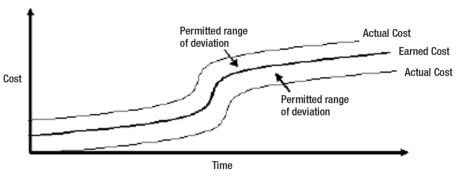The cost management plan is developed using the purchase plan and the following resources generated during Postal Service Supplying Practices Process Step 2: Evaluate Sources:
The cost management plan describes how CVs will be managed, should they occur. CV refers to the difference between AC and EV. The plan outlines the permitted range for cost deviation and response measures should cost deviate beyond the permitted range.
The cost management plan can be formal or informal, detailed or broad, depending on the complexity of the contract. The contracting officer must review the cost management plan regularly to ensure that its guidelines continue to be appropriate throughout the duration of the contract.
The following are suggested elements of a cost management plan:
The pricing analyst is responsible for determining the range by which cost will be permitted to deviate from budget. CV is calculated by comparing the AC of the work with the EV. CV is typically expressed as a ratio or percentage. The formula is:
CV = [(EV — AC) / EV] x 100
If the result is positive, the project is experiencing an “underrun.” If the result is negative, the project is experiencing an “overrun.”
The permitted range of deviation of AC from budget, or EV, may be dependent on:
Figure 5.1 illustrates the permitted range of deviation as falling between the AC and EV at any given point in the contract life cycle.
Figure 5.1
Permitted Range of Deviation

The permitted range of deviation may vary from project to project because of differences in scope and period of performance. For many purchases, variances are permitted to change over the contract duration because of the difficulty of forecasting costs accurately for long-term contracts. For manufacturing projects, allowed variances may be fixed over the duration of the project life cycle. For projects that involve R&D, for example, larger deviations may be allowed during the earlier phases of the project. However, in general, because the risk for any project decreases as time goes on, so should the allowed variance.
The cost management plan outlines how variances should be managed. The four main options are to:
Whether a CV falls within the permitted range of deviation will dictate the response measures. The choices available to manage a CV vary in terms of how drastic they are, how much work they require, and how much they change the contract. Ignoring the variance or making functional modifications are mild solutions. These choices require little or no work and make minimal changes to the project, if any. Replanning or making changes to the product scope are more drastic solutions that require a great deal of work and make substantial changes to the project. The contract management plan should anticipate situations that may necessitate each of the above options. Figure 5.2 suggests when each option should be used.
Figure 5.2
Response to Variances
Project replanning and product redesign involve major changes to the project. Both approaches require an assessment of the impact on the overall product quality and its ultimate usability by the client. Taking either of these approaches too far could render the product or service substandard.
When AC deviates from EV, it may be necessary to change the budget, rather than adjusting costs to match a previously determined monetary ceiling.
The following are valid reasons to change the budget:
The following are not valid reasons to change the budget:
The client must agree to the budget change request prior to seeking approval of additional funds.